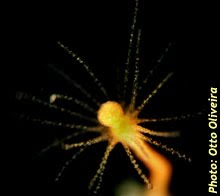
Most of the holoplanktonic organisms are known to release their gametes into the water, so that fertilization occurs externally to their body. This sexual reproduction pattern is a rule for most of the gelatinous marine animals, and it is not different with the pelagic comb-jellies. However, something different can occurs – at least occasionally – with the ctenophore Beroe ovata, seem in the figure above.
 As many other comb-jelly species, Beroe ovata is a hermaphrodite, developing male and female gametes simultaneously, in opposite sides of its longitudinal canals (see figure above). During the reproduction period, the gonads are empted alternately – ovules are released into the water first, followed by the sperm release (see figure below). This asynchrony is a mechanism to avoid the self-fertilization – at least inside the animal canals – once both genres of gametes are transported by the same canals to outside.
As many other comb-jelly species, Beroe ovata is a hermaphrodite, developing male and female gametes simultaneously, in opposite sides of its longitudinal canals (see figure above). During the reproduction period, the gonads are empted alternately – ovules are released into the water first, followed by the sperm release (see figure below). This asynchrony is a mechanism to avoid the self-fertilization – at least inside the animal canals – once both genres of gametes are transported by the same canals to outside. In most of the cases, fecundation occurs outside the parental bodies. However, in some Beroe ovata specimens from the São Sebastião Channel (southeastern Brazilian coast), living larvae could be observed swimming in gelatinous eggs, inside the parental bodies (see figure below). These larvae were located inside the diverticules – structures that links adjacent longitudinal canals. So, we believe that, in these cases, ovules and sperms produced in adjacent longitudinal canals could have “escaped” from the gamete releasing, migrating along the diverticules and than promoting the self-fertilization observed.
In most of the cases, fecundation occurs outside the parental bodies. However, in some Beroe ovata specimens from the São Sebastião Channel (southeastern Brazilian coast), living larvae could be observed swimming in gelatinous eggs, inside the parental bodies (see figure below). These larvae were located inside the diverticules – structures that links adjacent longitudinal canals. So, we believe that, in these cases, ovules and sperms produced in adjacent longitudinal canals could have “escaped” from the gamete releasing, migrating along the diverticules and than promoting the self-fertilization observed. For instance we could not estimate the rates of self-fertilization occurring in natural populations of Beroe ovata, nor the implications of that for its population stability. But the observation of this phenomenon, per se, is something new already in the knowledge of ctenophores reproduction.
For instance we could not estimate the rates of self-fertilization occurring in natural populations of Beroe ovata, nor the implications of that for its population stability. But the observation of this phenomenon, per se, is something new already in the knowledge of ctenophores reproduction.This Beroe ovata reproduction pattern was reported in Oliveira and Migotto (2006). A video, resuming the phenomenon, is available in the Ctenophores of the São Sebastião Channel webpage.
[Versão em português]
Autofecundação interna em ctenóforos pelágicos
Assim como várias outras espécies de ctenóforos, B. ovata é um hermafrodita, produzindo gametas masculinos e femininos simultaneamente em lados opostos de cada canal longitudinal (vide segunda figura). Durante o período reprodutivo as gônadas são esvaziadas alternadamente - inicialmente são liberados os óvulos e posteriormente o esperma (vide terceira figura). Tal assincronia consiste em um mecanismo que evita a autofecundação - ao menos no interior do corpo do animal - uma vez que os gametas de ambos os sexos são transportados para o exterior pelos mesmos canais.
Na maioria das vezes a fecundação ocorre externamente ao corpo parental. Porém, em alguns espécimes de Beroe ovata coletados no Canal de São Sebastião (costa sudeste do Brasil), observamos larvas se movimentando dentro de ovos gelatinosos no interior do corpo parental (vide quarta figura). Essas larvas estavam localizadas dentro de divertículos - canais ramificados que unem dois canais longitudinais adjacentes. Desta forma acreditamos que, nestes casos, óvulos e esperma produzidos em canais longitudinais adjacentes podem ter "escapado" para os divertículos durante a liberação dos gametas, permitindo a autofecundação no interior desses divertículos.
Por hora ainda não podemos estimar as taxas de autofecundação que ocorrem nas populações naturais, tampouco as implicações do fenômeno para a estabilidade genética destas populações. No entanto, a observação do fenômeno, por si só, já traz um contribuição para o conhecimento dos padrões reprodutivos dos ctenóforos.
A Autofecundação interna em Beroe ovata foi reportada por nós em Oliveira e Migotto (2006). Um vídeo, resumondo o fenômeno, pode ser visto no sítio Ctenóforos do Canal de São Sebastião.




No comments:
Post a Comment